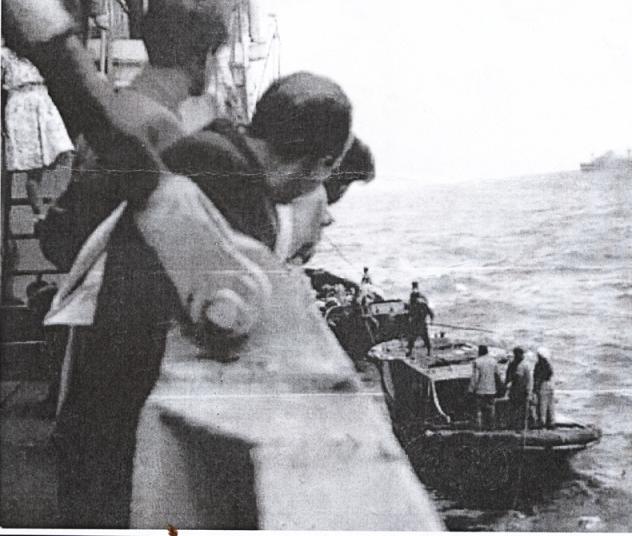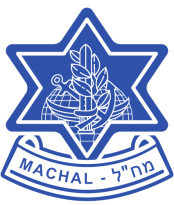(also known as JOHN BARRARD)
 I was born in Cape Town, and having served nearly four years in the South African Air Force during World War II, I was invited to join the nascent Israel Air Force.
I was born in Cape Town, and having served nearly four years in the South African Air Force during World War II, I was invited to join the nascent Israel Air Force.
In March 1948, after careful briefing, seven of us were sent by a regular passenger flight to Rome, trail-blazers for a route to Palestine. The need for absolute secrecy was impressed on us. We were not supposed to know each other, and we were given an address in Milan where we would receive further orders – all very hush-hush. It is important to remember how risky breaking the embargo was at that time; not only for us personally, but perhaps more importantly it could prevent the entry of desperately-needed, skilled personnel getting into Palestine.
Near Entebbe in Uganda, then still a British Colony, one of the engines of the Dakota taking us to Rome seized up. We landed safely, but had to wait for another engine to be flown up from South Africa. All the passengers were billeted in Nissen huts on the airfield for a week, which was a dangerous situation. At such times people start talking and finding out about one another. We kept a low profile and only casually “made acquaintance” with each other.
Eventually we flew to Rome, and after landing made our way by different routes and times to the Albergo Rosa, a small hotel in Milan. The pretense of non-recognition was elaborately continued, with whispers of “Tonight in Benny’s room, or Ozzie’s or Ronnie’s.” We attempted to make contact at the address we’d been given and had memorized. It was in the Jewish quarter, teeming with refugees desperately trying to get visas to enter Palestine. At first these refugees were very suspicious, and would not speak to us, but as I speak fluent Yiddish I was able to allay their doubts and establish our bona fides. They gave us some cash – we were running a bit short by then – and urged us to lie very low. Security was of the essence. The cloak-and-dagger stuff continued till one day, a huge Joint Distribution truck drew up outside the hotel with large Magen David symbols all over it. “Right, kumu chevra!” All security cover blown, and feeling rather sheepish, we paid our bills, scrambled aboard and were taken to Costelumbria near Monza in Northern Italy. The former home of the Cardinal d’Umbria, the castle was in a dreadful state. Three armies had been through it. We set-to and started cleaning the place up a bit.
We were then joined by five Jewish Danes and two non-Jewish Finns. We had to remove the labels from our clothing and give up our passports. In one section of the castle, out of bounds to everyone, was a group of Israeli artists who had served in the British Army. They had given their passports to refugees and stayed on in Europe. Extremely talented, they created and altered documents, official stamps and passports. I was given a refugee travel document with an unpronounceable name, and when I got my passport back in 1949 to go home, it had someone else’s photograph in it, with a perfectly embossed South African stamp! This, in turn, had to be reversed back to its original format.
Refugees were being brought in rapidly; they were mainly young men, but there were also older women and young girls, to give the appearance of an ordinary displaced persons camp when the U.N.W.R.A. people came round. On those occasions we, of course, mingled and pretended to be D.P.s. As well as speaking Yiddish, I read and write it. We had a small radio set, and were able to pick up the B.B.C. news which I translated and posted up for people to read. It was here that I got to know people who had been in the camps, and I was able to speak to them at length on a direct, close basis for the first time. It was then that I made the conscious, personal, resolution: “NEVER AGAIN.”
We spent Pesach in the camp. It was a pitiful shadow of Pesach, as supplies were short. But it was a most moving, yet exhilarating, experience. The singing, the jokes – (“Chicken soup? Well, the chicken must have run through mine very fast!” ) and the hopes of these survivors intent on “going home,” made up for any shortfall in the food.
Very early one morning we were aroused and hustled into coaches. At the docks in Venice, alongside a cargo boat, our “fixer” hurried up the gangplank, only to emerge a short while later with a negative shake of the head. We traveled cross-country to Genoa, and we pulled up alongside another cargo boat. Again, our fixer sped up the gangplank. This time he emerged with a broad grin on his face with the captain in tow, and beckoned us on board with all haste. On arrival off the coast near Tel Aviv, the Haganah was geared to our arrival, and sent small lighters to bring us ashore. We were packed into the boats like sardines, standing up with tarpaulins thrown over us. On landing we were helped off the boats and into waiting trucks and dispersed to various destinations. It was the 10th May 1948 and the Mandate had not yet ended.

Pre-State arrival to Tel Aviv of Jack Isaacson with the Danish and
Finnish group, waiting to be taken ashore
We were duly processed as new olim, and I was issued with the appropriate booklet, which I still have, and we swore our allegiance to defend the State of Israel; I was issued with an I.A.F. Identity Service booklet, which I also still possess, and our group was billeted to the Imperial Hotel on Hayarkon Street, which had been requisitioned as temporary quarters for Machalniks.
On the 14th May, the state was declared and in a dawn raid on the 15th, three Egyptian Spitfires virtually demolished the aircraft clustered in and around the single hangar at Sde Dov, the Tel Aviv airfield. In any other Air Force those airplanes would have been a write-off. But here there was no choice. They were painstakingly restored, parts were made or cannibalized, and they flew again. Fortunately, a number of clapped-out Austers, the little airplanes used by flying clubs, had been purchased from the R.A.F. in January 1948, the officer in charge having been persuaded that they were virtually useless. They were dispersed to various locations, and the 21 “scrap” Austers were reassembled into a smaller number of usable aircraft. But they were very slow and had no night-flying instruments. So in the first hectic weeks after the declaration of the state, I worked almost continuously round the clock at Sde Dov, fitting those little planes with Venturi Tubes and basic night-flying instruments so they could be used as bombers, with crude hand-made bombs chucked over the side. The role of those little planes, the Austers, Pipers and Fairchilds, in the first crucial weeks before the Czechoslovakian Airlift brought in the Messerschmitts, tend to be overlooked. But they were vital in checking the better-equipped enemy’s rapid advances, as well as flying in mail and urgently needed medical supplies to isolated areas. One of those little Austers used to stand mounted on a plinth outside Sde Dov, in recognition of the role they played. Sadly, it was later removed, a great pity as it put the inequality of resources into perspective and served as a reminder of the grave danger the new little state faced in May 1948.
It was during the first truce in June that I witnessed the unfortunate “Altalena” incident. Some of us were armed with Sten guns to guard the old Park Hotel, also a requisitioned billet for Air Force personnel, just a few hundred yards away from the beached, fiercely blazing vessel opposite the Kaete Dan Hotel This was a most disturbing time for us. We had come to help defend Israel against Arabs and here we saw, at first hand, Jews viciously fighting Jews. Fortunately, the matter was eventually resolved. But the bitterness of that internal conflict lingers on to this day.
After the first truce, I was transferred to Air Force Intelligence. Following a period of training, towards the end of 1948 three small units were formed, consisting of an operations officer, an intelligence officer and either a radio operator or aerial photographer. They were to be attached to one of the sectors – southern, central and northern, doing air-ground liaison. My first posting was to the southern sector. But soon after arrival I injured my back severely enough to require hospitalization and a period of convalescence. When pronounced fit enough, I joined the Central Sector liaison unit as Intelligence Officer, with Arye (Kappy) Kaplan, a fellow South African, as operations officer and pilot, and Leslie Kapuza, a Londoner, as aerial photographer. We had at our disposal a small Piper Cub for aerial photographic reconnaissance We were based at Ramle under the overall command of Yigal Alon. Here I served until after the final armistice in 1949, when I returned to South Africa via Europe and London. In 1950 I settled in London and after spinal surgery, resumed my career as a professional actor.
As it is my firm conviction that ex-Machalniks can and should continue the fight on behalf of Israel by fund-raising and countering anti-Israel propaganda, I have also been active in these areas for many years.

